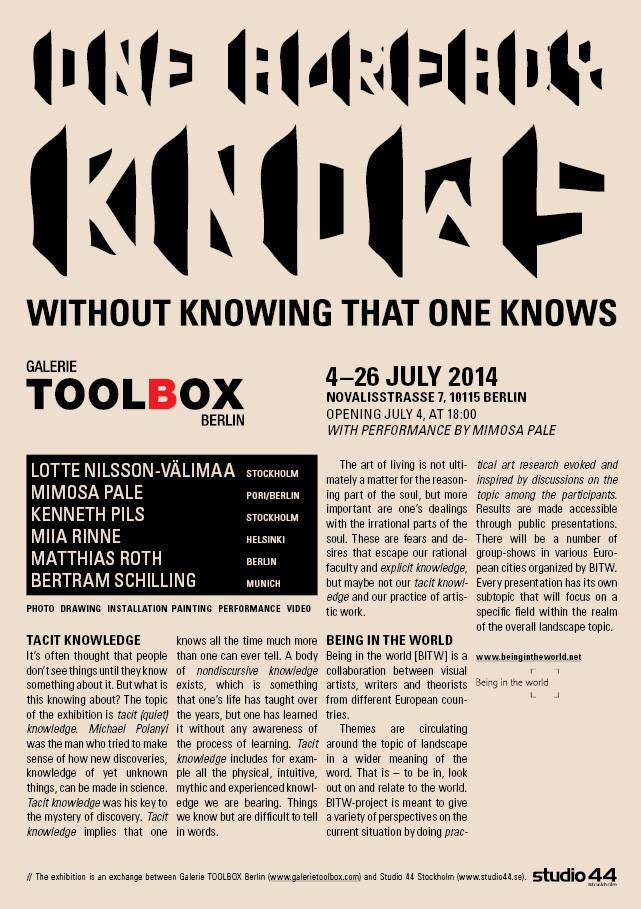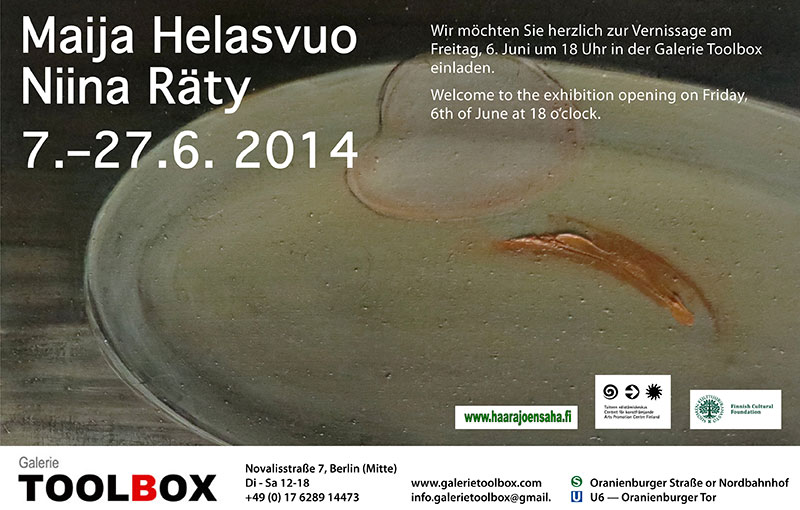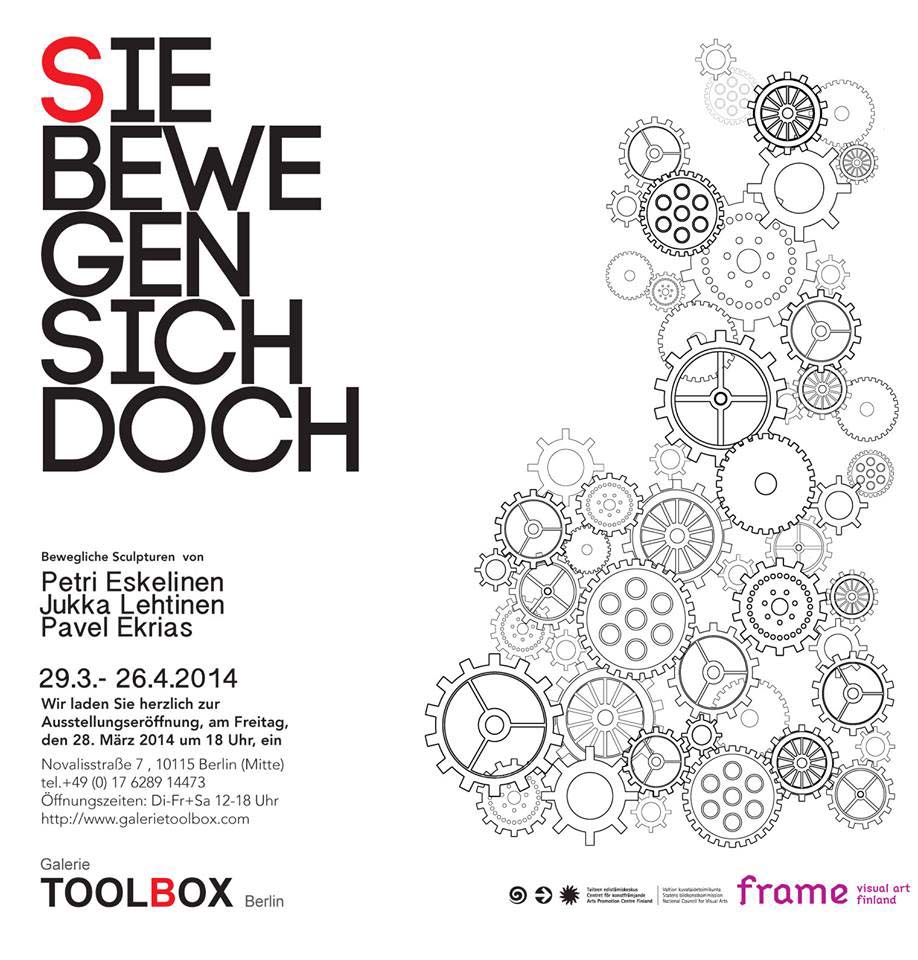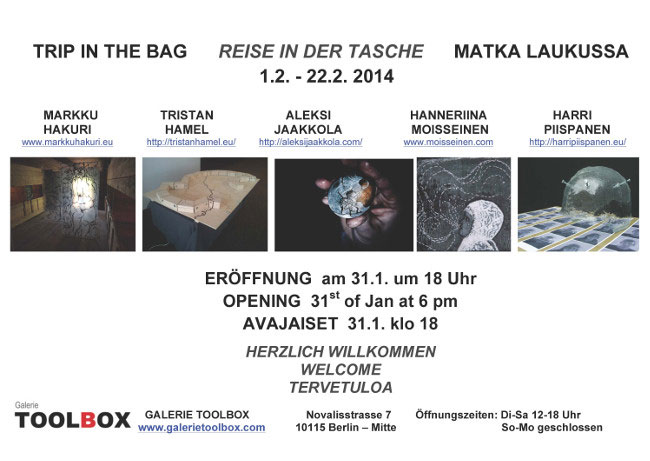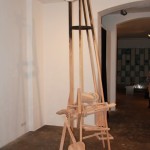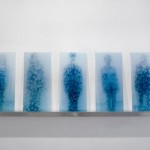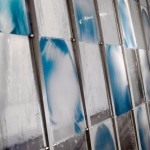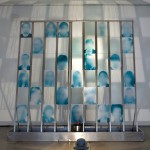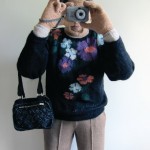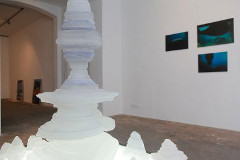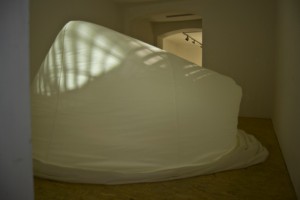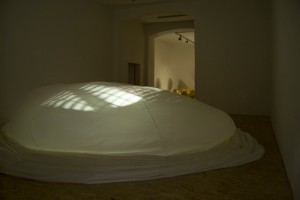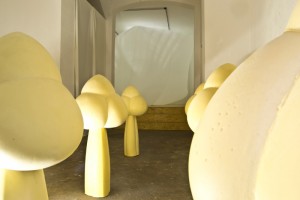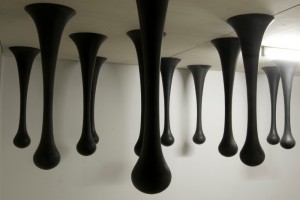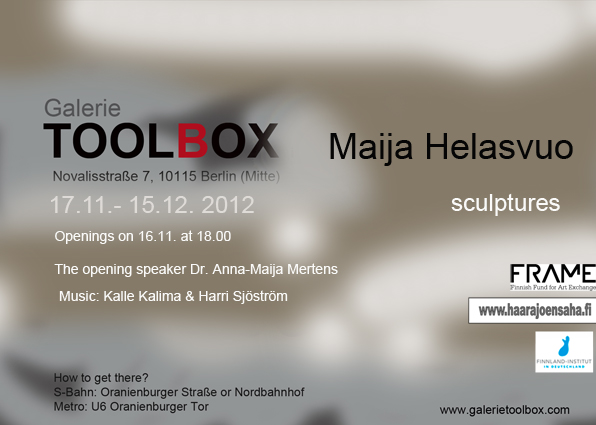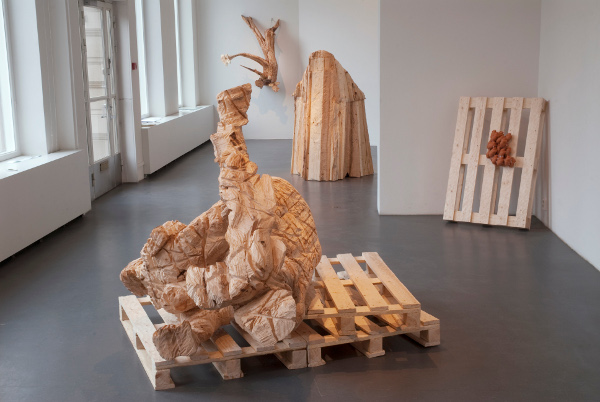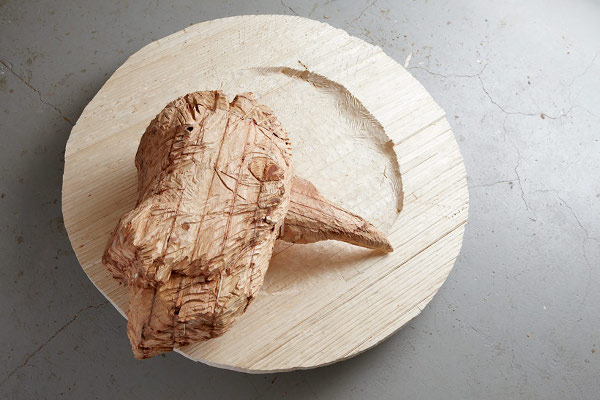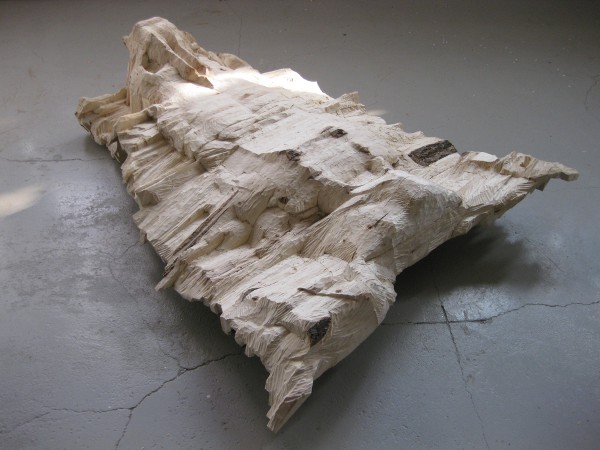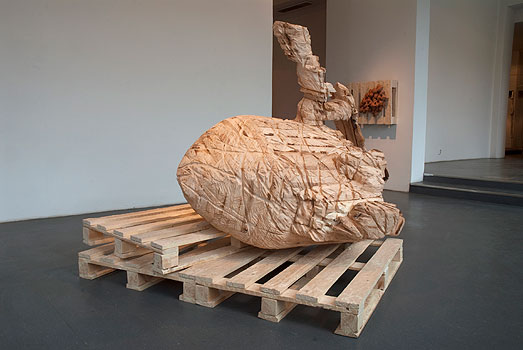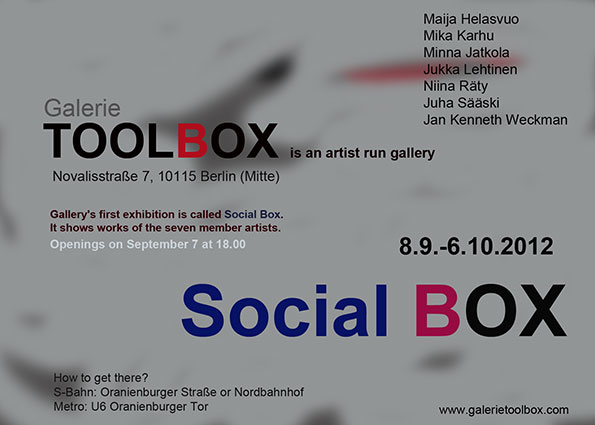Artists: Lotte Nilsson-Välimaa, Mimosa Pale, Kenneth Pils, Miia Rinne, Matthias Roth, Bertram Schilling
All posts tagged “Sculpture”
Maija Helasvuo/Niina Räty 7.–27.6.2014
Welcome to the exhibition opening of Maija Helasvuo and Niina Räty
on Friday 6th of June 2014 at 18.00 o’clock at Galerie Toolbox.
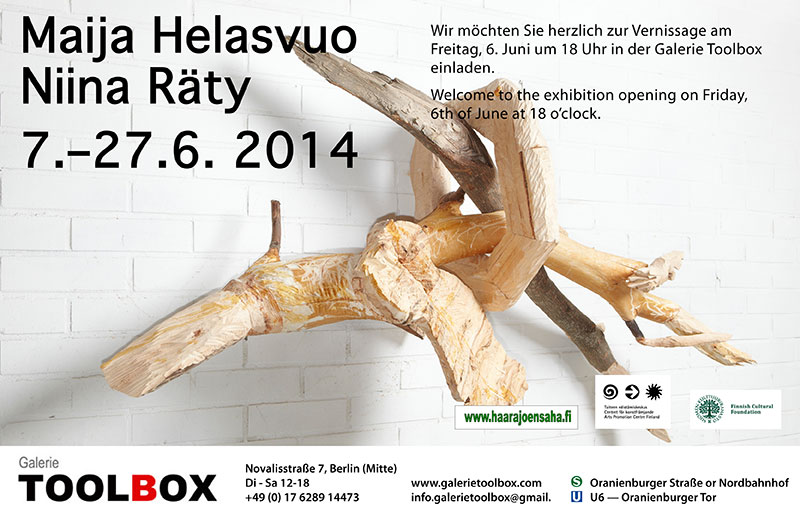 Maija Helasvuo, sculptor
Maija Helasvuo, sculptor
At the centre of Maija Helasvuo’s art, are the different levels of human feeling. Her sculptures picture peoples basic emotional dynamic; loss, vulnerability, closeness and our dependence on social interaction. Each person is a part of the complete community of humanity. Through communal experience and all the social forms within it, the process of an event is formed, the connection and interaction of which makes up the whole content of human society.
That which acts on the powerful emotions inside society as a directing force is in one way or another a common factor and causes a process of emotional adaptation. Things that happen in our environment affect us. Helasvuo’s sculptures picture this invisible influence, which is at once adaptable and concrete.
Dr. Mika Karhu
Niina Räty, painter
I mostly paint large multi-part series of works.
I create my own photo album via painting, depicting close people and places as seen through my own experiences. I seek the things that life and existence attach to. I choose a situation or a space that is private and universal like a family gathering, holiday in a summer cottage or a plate on a kitchen table. In my paintings, just like in front of a camera there is a composition; a wedding couple just like other wedding couples around the world, a tourist in front of a local sight forms a picture – a composition that we all are familiar with from our own holiday photos.
We try to capture important moments in our own album and as we take the pictures they represent the form of the event. Compositions using this formula illustrate our own life story. Perhaps through this mechanics of social and spatial being we have a fleeting chance of understanding other people.
Surely painting, restructuring the world on a canvas into a more comprehensible shape is always also a form of self-therapy, organising and tidying up one’s own place, choosing a perspective which helps to tolerate life’s chaos. This aspect of the creative process is, besides sharing and reaching out for another person, central to my artistic work.
Niina Räty
Und sie bewegen sich doch | 29.3.–26.4.2014
Bewegliche Sculpturen von Petri Eskelinen, Jukka Lehtinen und Pavel Ekrias
The exhibition presents three artists whose works are linked together through the use of mechanical physical movement. The title of the exhibition – Sie bewegen sich doch – refers to the utterance ”Eppur si muove” by Galileo which translates as ”Und sie bewegt sich doch” in German. The name ”Sie bewegen sich doch” can also be perceived pointing to the feeling of relief the artist experiences when he after a lengthy process is able to finally see his work functioning.
The pieces of all three artists of the show also contain humor and twinkle brought about by movement. The pieces interact with the audience. The works by Eskelinen demand the viewer to participate physically and to challenge one’s senses in interaction with the piece. The work by Ekrias emotionally captivates the viewer – the repetitious monotonous spanking is downright enchanting to follow. The piece by Lehtinen on the other hand concretely captivates the viewer for a little while inside the curtain.
In der Ausstellung präsentieren drei Künstler ihre Werke, die alle ein gemeinsames Merkmal tragen: sie sind mechanisch, beweglich. Der Titel der Ausstellung „Sie bewegen sich doch” bezieht sich auf den Spruch von Galileo „Eppur si muove” (Und sie bewegt sich doch). Darüber hinaus könnte der Satz „Sie bewegen sich doch” als ein Hinweis auf die Erleichterung des Künstlers gesehen werden, wenn er endlich nach einem langen Arbeitsprozess sein Kunstwerk funktionieren sieht.
Näyttelyssä on kolme taiteilijaa, ja teoksia yhdistää mekaaninen fyysinen liike. Näyttelyn nimi Sie bewegen sich doch viittaa Galileon lausahdukseen Eppur si muove , joka saksan kielellä tunnetaan muodossa Und sie bewegt sich doch. Nimen Sie bewegen sich doch voi nähdä viittaavan myös taiteilijan helpotukseen, kun hän pitkän työprosessin päätteeksi näkee teoksensa vihdoin toimivan.
Trip in the Bag | 1.–22.2.2014
he metamorphoses of a bag and its content to an installation, February 1st – February 22nd, 2014
Opening January 31st.
Artists’ homepages: Markku Hakuri, Tristan Hamel, Aleksi Jaakkola, Hanneriina Moisseinen, Harri Piispanen
3Räume –Three Sculptors
5.–26.10.2013
Liisa Hietanen, Johanna Ilvessalo
and Anneli Sipiläinen
Exhibition opening 4th of October at 18—20 o’clock.
Welcome!
Liisa Hietanen (1981), Johanna Ilvessalo (1964) und Anneli Sipiläinen (1940) sind Bildhauerinnen aus unterschiedlichen Generationen und sind somit in verschiedenen Stadien ihrer Laufbahn. Die Unterschiede der Arbeitstechniken, und somit des Denkens der drei, schaffen einen lebhaften Dialog in der Ausstellung. Durch kompromisslose visuelle Umsetzung die Welt und den Menschen zu untersuchen, ist was die Arbeiten dieser Künstlerinnen vereint.
Kurator Bildhauerin Maija Helasvuo
Liisa Hietanen
Ich häkle und stricke meine Skulpturen. Die Technik ist zu einem Teil meines Denkens geworden. Sie ist stetig und anwesend. Sie gibt einem Portrait Zeit seinen Charakter zu finden und einem Objekt einen langsamen Drall.
In meiner Arbeit begegne ich fortwährend Unterschieden zwischen mir und anderen. Ich denke über soziale Grenzen nach – Dinge die uns trennen aber andererseits auch besonders vereinen. Ich bin an diesen Erfahrungen, und Dingen die wir als Menschen teilen, interessiert.
Johanna Ilvessalo
Meine Raumarbeiten bestehen aus unterschiedlichen Elementen; Bild, Bewegung, Licht, Schatten und Klanglandschaft.
In meinen Arbeiten untersuche ich die Zerbrechlichkeit und Verletzlichkeit des Lebenslaufes mit Kombinationen von Licht, fließendem Wasser und Fotografien. Die menschlichen Gesichter sind in der Ausstellung verborgen oder verwittert, alles was übrig bleibt ist eine vage Figur, eine Gruppe ferner Erinnerungen.
Durch die Gegenüberstellung von Gesichtslosigkeit und Wassertropfen verändert sich das gewöhnliche Portrait zu etwas völlig anderem. Fotografien sind keine Erinnerungsträger mehr, sondern nehmen eine neue Rolle als Symbole von Vergessenheit, Abkehr und Entfremdung an.
Anneli Sipiläinen
In meinen Arbeiten steht oftmals der Mensch im Mittelpunkt, obwohl die Skulptur äußerlich zum Beispiel die Form eines Tiers anzunehmen scheint. Ich denke an die Gegensätzlichkeit des Lebens, seine scheinbare Stärke – die Sicherheit des Alltags – und andererseits seine unerwartete Zerbrechlichkeit.
Ich arbeite gerne mit Holz. Sein Wesen erlaubt es große Skulpturen von Hand zu fertigen. Wenn nötig, erziele ich mit dem Einsatz von Maschinen eine vollständig andere Wirkung. Holz ist ein warmer und sichererÜbersetzer von Gedanken.
Die Austellung wurde unterstützt von Frame Visual Art Finland.
3Räume / Three Sculptors
Liisa Hietanen (b. 1981) Johanna Ilvessalo (b. 1964) and Anneli Sipiläinen (b. 1940) are three different aged sculptors at a different phase of their career. The differences between their techniques and thus their thinking makes this exhibition vividly conversing and therefore specially interesting for the viewer. Studying the world and human being through uncompromising and refined visual making of works, is what combines these artists works.
Curator Sculptor Maija Helasvuo
Liisa Hietanen
I crochet and knit my sculptures. The technique has become a part of my thinking. It is continuous and present giving a portrait time to reach its character and a slow twist to an object.
In my work I constantly meet a difference between me and others. I find myself thinking of social boundaries, things that separate us, but on the other hand especially unite us. I am interested in those experiences and things that we as human beings share.
Johanna Ilvessalo
My spatial works are formed with many different elements; picture, movement, light, shadow and soundscape.
In my works I have studied the fragility and vulnerability of the lifespan with combinations of light, flowing water and pictures. In the exhibition the pictures of human faces are hidden or worn away, all that is left is a vague figure, a group of distant memories.
By juxtaposing facelessness and drops of water the ordinary portrait changes to something completely different. Photographs stop being savers of memory and they get a new role as symbols of oblivion, abandonment and alienation.
Anneli Sipiläinen
In my works the human being is often in a main role although the form of the sculpture would appear to get a shape of for example an animal. I think of the contrariety of life, its apparent strength – the safety of everyday – and in the other hand unexpected fragility.
I like to use wood as my material, its essence makes it possible to make large sculptures by hand and if necessary with machines I can achieve a completely different kind of look. Wood is a warm and safe interpreter of thought.
The exhibition has been supported by Frame Visual Art Finland.
3Räume / Kolme kuvanveistäjää
Liisa Hietanen (s. 1981) Johanna Ilvessalo (s. 1964) ja Anneli Sipiläinen (s. 1940) ovat kolme eri ikäistä ja uransa eri vaiheissa työskentelevää kuvanveistäjää. Heidän tekniikoidensa ja sitä kautta ajattelunsa erilaisuus tekee juuri tästä näyttelystä vilkkaasti keskustelevan ja siksi katsojalle erityisen mielenkiintoisen.
Heidän työskentelyään yhdistää sisällön vahvuus, maailman ja ihmisenä olemisen pohdinta tinkimättömän ja viimeistellyn visuaalisen toteuttamisen kautta.
Näyttelyn kuraattori kuvanveistäjä Maija Helasvuo
Liisa Hietanen
Virkkaan ja neulon veistokseni. Tekniikastani on muodostunut osa ajatteluani. Se on jatkuvaa ja läsnäolevaa antaen muotokuvalle aikaa saada luonteensa ja esineveistokselle hitaasti vinksahtaneen olemuksen.
Työskentelyssäni törmään jatkuvasti eroon minun ja muiden välillä. Huomaan pohtivani sosiaalisia rajoja, asioita jotka erottavat meitä, mutta toisaalta etenkin yhdistävät. Minua kiinnostavat ne kokemukset ja asiat, jotka me inhimillisinä olentoina jaamme.
Johanna Ilvessalo
Tilateokseni rakentuvat useista eri elementeistä; kuvasta, liikkeestä, valosta, varjosta sekä äänimaisemasta.
Teoksissani olen tutkinut ihmisen elämänkulun haurautta ja haavoittuvuutta valon ja heijastuksen, virtaavan veden sekä kuvien yhdistelminä. Näyttelyn kuvissa ihmisten kasvot ovat piilossa tai kuluneet pois, ja heistä on jäljellä vain epämääräinen hahmo, joukko etäisiä muistoja.
Rinnastamalla kasvottomuuden ja vesipisarat muuttuu tavallinen muotokuva joksikin ihan muuksi. Valokuvat lakkaavat olemasta muiston tallettajia, ja ne saavat uuden roolin unohduksen, hylkäämisen ja vieraantumisen symboleina.
Anneli Sipiläinen
Teoksissani on useimmiten pääosassa ihminen,vaikka veistoksen hahmo näyttäisikin saavan esimerkiksi eläimen hahmon. Ajattelen elämän vastakohtaisuutta, sen näennäistä vahvuutta – arkipäivän turvallisuutta – ja toisaalta odottamatonta haurautta.
Käytän materiaalina mielelläni puuta, sen olemus mahdollistaa suurtenkin veistosten käsin tekemisen ja tarvittaessa voi koneiden avulla saada aivan toisen tyyppistä jälkeä. Puu on ajatuksen tulkkina lämmintä ja turvallista.
Näyttelyä on tukenut Visuaalisen taiteen keskus Frame.
Wavering View 16.2.–16.3.2013
GOOD HEAVENS | Jukka Lehtinen | 12.1.–9.2.2013
Installationen
Jukka Lehtinen
Maija Helasvuo | sculpture, 17 .11.–15.12.2012
Social isolation, 13.10.–10.11. 2012
The exhibition was preceded by an international workshop between the participating artists Maiju Heikkilä (Fin), Anna Tahkola (Fin), Elisabeth Buset (Can), Janne Kärkkäinen (Fin), Sampsa Ingren (Fin), Jonna Sivonen (Fin), Anne Rossi (Fin), Erkki Nampajärvi (Fin), Matti Vainio (Fin) and Annika Bergvik‑Forsander (Fin)
Social Isolation
Social Isolation, the second exhibition of the new Berlin based art gallery Galerie TOOLBOX, consists of drawings by ten young artists discussing themes of social alienation from a variety of perspectives. The exhibition is based on a concentrated drawing workshop occurring in the gallery, during which every artist implements one work and participates in the creation of one collective work.
The exhibition approaches the social aspects of modern culture from the concept of alienation. What does alienation mean in modern Europe? How can it be treated with the means of art?
The idea of social alienation originates from the philosophy of Georg Hegel (1770–1831). The term of alienation has been especially connected with the theory of Karl Marx. It is one of the most used theories in social sciences and also in modern art.
Alienation deals with the vanishing of human and natural values in a fragmented and objectified social reality. The working culture, with its emphasis on competitiveness, also escalates social relations. The meaning of human dignity and labour is blurred, when man is above all required to conform to be a part of machinery. The satisfaction of understanding totalities, like finishing a work from beginning to end, is a natural human desire. The structural violence of the society, such as fragmentation that creates weakness or connecting human dignity to the ideal of productivity alienates man from nature, other people, his or her own feelings and needs. We require a human dignity that is independent of economy, production and consumption, a freedom to a more comprehensive life in order to be able to recognize man and nature in connection to us, belonging to our own humanity.
Social Isolation brings artists used to independent and lonely work, to work in a commonly shared space. The exhibition and workshop enable the sharing of art and work, and the joy of producing a work from beginning to end.
Artists of exhibition are Maiju Heikkilä (Fin), Anna Tahkola (Fin), Elisabeth Buset (Can), Janne Kärkkäinen (Fin), Sampsa Indgrén (Fin), Jonna Sivonen (Fin), Anne Rossi (Fin), Erkki Nampajärvi (Fin), Matti Vainio (Fin) ja Annika Bergvik-Forsander (Fin).
Galerie TOOLBOX is a cooperative of seven Finnish artists in the centre of Berlin, in Mitte. The gallery represents Finnish and international art from the perspective of social questions.
Social Isolation
Uuden berliiniläisen Galerie TOOLBOXin toinen näyttely Social Isolation koostuu 10 nuoren taiteilijan teoksista, jotka käsittelevät sosiaalisen eristäytymisen teemoja eri näkökulmista. Näyttelyn pohjana on gallerian tiloissa järjestettävä piirustusworkshop, jonka aikana kukin taiteilijoista toteuttaa yhden teoksen ja osallistuu yhden yhteisteoksen tekemiseen.
Näyttely lähestyy nykykulttuurin sosiaalisia näkökulmia vieraantumisen käsitteestä käsin. Mitä vieraantuneisuus tarkoittaa nyky-Euroopassa? Miten sitä voi käsitellä taiteen keinoin?
Alkujaan ajatus yhteiskunnallisesta vieraantumisesta tulee saksalaisen Georg Hegelin (1770 – 1831) filosofiasta. Vieraantuneisuuden termi on myöhemmin liitetty etenkin Karl Marxin teoriaan. Se on yksi käytetyimmistä teorioista yhteiskuntapolitiikassa ja myös nykytaiteessa.
Vieraantuneisuudessa on kysymys inhimillisten ja luonnollisten arvojen katoamisesta sirpaloituneessa ja esineellistetyssä yhteiskunnallisessa toiminnassa. Kilpailukykyä korostava työkulttuuri laajenee koskemaan myös sosiaalisia suhteita. Niin ihmisarvon kuin työnkin merkitys hämärtyy, kun ihmiseltä vaaditaan ennen kaikkea sopimista koneiston osaksi. Kokonaisuuksien ymmärtämisen, niin kuin työn alusta loppuun saattamisen nautinto on ihmiselle luonnollinen, inhimillinen tarve. Yhteiskunnan rakenteellinen väkivaltaisuus, kuten voimattomuutta aiheuttava sirpaleisuus tai ihmisarvon sitominen tuottavuuden ideaaliin vieraannuttaa ihmistä luonnosta, toisista ihmisistä, omista tunteistaan ja tarpeistaan. Tarvitsemme taloudesta, tuotannosta ja kuluttamisesta vapaata ihmisarvoa, vapautta kokonaisvaltaisempaan elämään, jotta voisimme tunnistaa ihmisen ja ympäristön luonnollisesti meihin liittyviksi, omaan ihmisyyteemme kuuluviksi.
Social Isolation tuo itsenäiseen ja yksinäiseen työhön tottuneet taiteilijat työskentelemään yhteisesti jaettuun tilaan. Näyttely ja workshop mahdollistaa taiteen ja työn jakamisen, sekä alusta loppuun asti valmistuvan työn tekemisen ilon.
Näyttelyn taiteilijat ovat Maiju Heikkilä (Fin), Anna Tahkola (Fin), Elisabeth Buset (Can), Janne Kärkkäinen (Fin), Sampsa Indgrén (Fin), Jonna Sivonen (Fin), Anne Rossi (Fin), Erkki Nampajärvi (Fin), Matti Vainio (Fin) ja Annika Bergvik-Forsander (Fin). Workshopin ja näyttelyn tutorina toimii kuvataiteilija Mika Karhu. Lisäksi workshopissa luennoi filosofi FT Pentti Määttänen.
Galerie TOOLBOX on seitsemän suomalaisen kuvataiteilijan ylläpitämä galleria Berliinin keskustassa, Mittessä. Galleria esittelee suomalaista ja kansainvälistä taidetta yhteiskunnallisten ja sosiaalisten kysymysten tiimoilta.
Social Box | 8.9.–6.10.2012
Showing the works of the cooperative members Maija Helasvuo, Minna Jatkola, Mika Karhu, Jukka Lehtinen, Niina Räty, Juha Sääski and Jan Kenneth Weckman
Opening on the 7th of September at 18.00.
